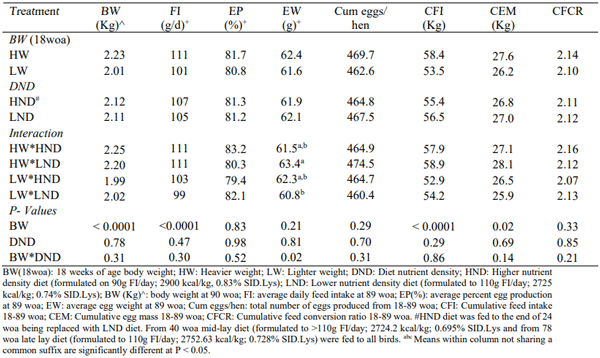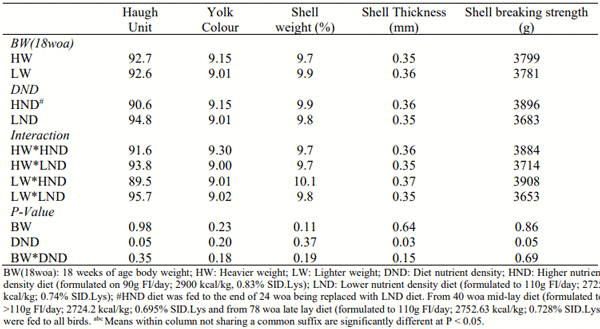I. Introduction
Pullet body weight (BW) has significant impact on hen sexual maturity, egg productivity and flock uniformity (Lacin et al. 2009). Australian layer flocks are frequently 100-300 grams heavier than breed standard weight (BSW) (Parkinson et al. 2015). These birds typically lay larger eggs than LW hens and higher BW is symptomatic of bird obesity which can result in the production of excessively large eggs with lower eggshell quality and poorer persistency of lay in late lay compared to smaller sized birds. Therefore, rearing pullets of BSW or slightly smaller size may improve laying persistency and egg quality when birds are to be in production beyond 80 woa.
Globally the layer industry is extending layer hen productive life to 100 woa to realise benefits in industry sustainability (Dunn, 2013). But, for this to succeed, longer term efficient hen productivity, hen health and eggshell quality need to be achieved (Bain et al. 2016). The better feed efficiency of smaller sized hens (Akter et al. 2019) is appealing in a longer laying cycle. However, as smaller hens have lower FI compared to larger sized hens (Harms et al. 1982) they may not consume adequate diet for their nutritional needs, especially when the diet is formulated on BSW daily FI (Leeson et al. 2001).
A diet of higher nutrient density (HND) at the start of lay could circumvent challenges of lower FI in LW hens enabling them to attain required nutrients within their lower daily FI. This diet may also prime these birds for sustained egg production. This study compared the persistency of lay, eggshell quality and feed efficiency of HW and LW point of lay pullets fed either a HND or LND diet during early lay.
II. Materials and methods
This study was a 2 × 2 factorial arrangement consisting of 2 nutrient densities (HND and LND) and 2, 18 woa bird weight groups: mean weight 1.65 kg (HW) and 1.49 kg (LW). When 16 woa, 240 ISABROWN pullets were purchased from a grower, transported to University of Sydney, Camden and housed in the high-rise layer shed in individual pens (25 × 50 × 50 cm) each with an individual feeder and waterer. Pullets were fed the LND diet ad libitum and allowed to acclimate for a 2-week period. All birds were weighed at 18 woa and 120 pullets were allocated to each weight group (HW or LW). Sixty pullets from each weight group were randomly assigned to either a HND (formulated on 90g FI/day; 2900 kcal/kg, 0.83% SID.Lys) or LND (formulated to 110g FI/day; 2725 kcal/kg; 0.737% SID.Lys) diet. They were fed the experimental diets from 18 to 24 woa. At 25 woa hens on HND diet were consuming at least 100g FI/day and were transferred to the LND diet. At 40 woa all hens were moved to a midlay diet (formulated to > 110g FI/day; 2724.2 kcal/kg; 0.695% SID.Lys and then at 78 woa a late lay diet (formulated to 110g FI/day; 2752.63 kcal/kg; 0.728% SID.Lys) which they received until 90 woa. From 18-89 woa individual hen egg production (EP), egg weight (EW) and FI were measured to allow weekly determination of egg mass (EM), FCR and cum. production. Between 86-90 woa eggs from 12 focal birds /treatment group were assessed for egg quality each week. Data were analysed using a factorial ANOVA with 18 woa BW and diet nutrient density as the main effects.
III. Results and discussion
Typical of Australian conditions the 16 woa pullets were above BSW but HW and LW pullets were selected without drawing from the extremities of the flock. Hen weight and production are presented in Table 1. Production data is presented to 89 woa as bird sampling during 90 woa (data not shown) prevented those birds from contributing to a full week of production data. Therefore, to include at least 32 birds in each treatment group for statistical analysis, 89 woa data was used.
Average BW at 90 woa and 89 woa average daily FI, 18-89 cum. FI (CFI) and cum. egg mass (CEM) of HW birds were significantly higher (P < 0.05) than the LW birds. Heavy weight birds at 18 woa were 10.7% heavier than LW birds and 10.9% heavier at 90 woa. Hence LW birds did not undergo compensatory growth which has also been reported for HyLine Brown hens (Perez-Bonilla et al. 2012). HW birds had an average 9.2% higher cum. FI to produce an additional 5.3 % cum. egg mass or, for each additional 100 g BW at 90 woa they consumed an additional 4.5 g/d feed and produced an additional 0.36 g/d EW. In comparison, Leeson and Summer (1987) identified an average increase of 3.5g FI and 1.2g EW for each 100 g increase in BW in Leghorn hens. Diet density only impacted EW at 89 woa, where a significant interaction (P = 0.02) resulted in the highest EW for HW LND diet treatment birds compared to LW LND diet birds. However, there were no significant differences in 89 woa egg production nor cumulative eggs produced per hen. Cumulative FCR was not significantly different however at 69 woa the LW hens had significantly lower cumulative FCR (data not shown) and continued with the lowest cum. FCR to 89 woa. In light of the preference for HW hens in Australia it is interesting to consider a simple cost benefit analysis to 89 woa on the cost of the additional 4.9 kg of feed consumed by HW birds with the return for their additional 7 eggs compared to LW hens.
Interestingly the HND diet did not initiate a significant reduction in FI to the end of 24 woa (data no shown). This lack of FI adjustment for diet nutrient density has been identified previously (Morris, 1968; Jalal et al. 2007) while adjustment in FI due to diet density has been reported by others (Perez-Bonilla et al. 2012; dePersio et al. 2015). The reason behind these differences is not immediately evident.
Table 1 - Hen weight, week 89 production and weeks 18-89 cumulative production

The effects of BW and diet nutrient density on egg quality assessed across 86-90 woa are presented in Table 2. Haugh units of birds on HND diet were significantly lower (P = 0.05) than the LND diet; however both measures were above 90. Perez-Bonilla et al. (2012) also observed a significantly lower Haugh unit in eggs from 56-59 woa Hy-line Brown hens fed a higher energy diet, but it should be noted those hens consumed the treatment diets from 24-59 woa, as opposed to this study where the dietary treatments were fed in early lay only. dePersio et al (2015) also noted a decline in Haugh unit in Hy-line W36 hens between 33-70 woa when hens had consumed the higher energy compared to the lower energy diet from 19-70 woa. Yolk colour and % shell weight were not different, the latter also being reported by Perez-Bonilla et al (2012). As seen in Table 2 percent shell was at or above 9.7% being the minimum below which the number of shell fractures tends to increase (Abdallah et al 1993). Importantly the HND diet fed during early lay resulted in significantly thicker eggshell (P = 0.03) and higher (P = 0.05) shell breaking strength. Literature on eggshell thickness and shell breaking strength due to diet nutrient density is limited, however both dePersio et al (2015) and Hassan et al (2013) found no difference in shell breaking strength with higher energy diets.
While the HW birds had the highest cum FI, cum EM and cum. FCR, LW hens and particularly the LW birds on the HND diet had the lowest cum FCR and no difference in egg production. The HND diet also increased the shell thickness and shell breaking strength. Hence LW hens can perform across a long laying cycle with benefits in their production and egg quality from a HND diet fed in early lay. These treatments should be evaluated in cage free systems.
Table 2 - Egg quality at 86-90 weeks of age
ACKNOWLEDGMENT: This research was funded by Australian Eggs
Presented at the 33th Annual Australian Poultry Science Symposium 2022. For information on the next edition, click here. 











.jpg&w=3840&q=75)